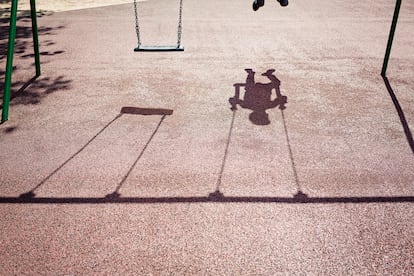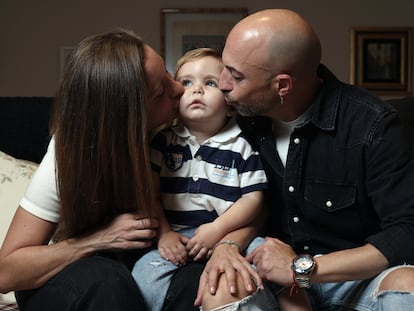A single swing does not make a park inclusive: The importance of equal play and socialization
The challenge of playgrounds lies in ensuring that all children, regardless of ability, receive equal stimulation and challenge. Well-designed play spaces can break down social barriers and remove the stigma associated with disability


In his book Jugar [Play], educator André Stern states that children do not differentiate between living, learning, and playing. “They think of it as an organic entity. All children play, regardless of their environment,” he writes. However, not all of them have the same opportunities, not all parks and play spaces are suitable for those who live with functional diversity. Playground accessibility continues to be a challenge. Children have the right to play, as insists Joaquín Susmozas, the father of Julia, a nine-year-old girl with disabilities. This pediatrician and his daughter are part of a team of atypical runners that looks to visibilize functional diversity among kids through participating in races, posting images from their events on social networks like Instagram, or on their YouTube channel. “The parks don’t have the elements that make play possible for kids with disabilities,” says Susmozas.
Article 31 of the Convention on the Rights of the Child establishes that: “States Parties shall respect and promote the right of the child to participate fully in cultural and artistic life.” Susmozas, whose little one has a rare disease called Beckwith-Wiedemann, says that cities should discontinue policies that leave children with disabilities in the shadows. Due to various complications, his daughter developed cerebral paralysis. Together, they run thousands of kilometers with several different goals: to increase visibility of people with disabilities, fight for their rights, and inclusion.
Ana Mourelo, who works with Barcelona’s first inclusive park and is the founder of the Miradas que Hablan (Looks that Speak) association — which owes its name to the fact that some children with disabilities are non-verbal — and mother of Aitor, who recently died from complications resulting from MECP2 duplication syndrome, is also part of this fight. Mourelo and José Brocal founded the association with three goals: research, dissemination, and family reunification. Since then, they have not stopped fighting and raising funds for research in search of a cure for all children suffering from the disease.
Mourelo emphasizes the need for parks to be accessible, adaptable, and inclusive, because a single swing does not make a park inclusive all on its own. It is useless for a child with a disability to have access to a park if he or she cannot use and enjoy it. Likewise, she considers it important that play spaces allow the participation of children both with and without disabilities, encouraging their interaction and avoiding curious looks. The challenge of inclusive playgrounds is to ensure that all children, regardless of ability, receive the stimulation and challenge they need equally. Another issue raised by Mourelo is the importance of awareness-raising campaigns around the proper use of these playgrounds, given the high cost of some elements such as elevating platforms.
What should an inclusive playground offer?
According to a study on inclusive playgrounds by CERMI (Spanish Committee of Representatives of People with Disabilities), these spaces should:
1. Provide accessibility inside and outside of the playground. There must be space so that children can move around in a wheelchair.
2. Offer resources and alternatives to access and use existing elements so that all can participate and play according to their capabilities.
3. Feature a variety of sensory and recreational experiences that provide physical, cognitive, emotional and social benefits.
4. Encourage cooperative learning.
The more varied the play and experiences, the more options of play elements that are offered, the more inclusive the park will be. It could also prove interesting to add challenging elements that provoke interest among the more mobile. Consideration could be given to incorporating play and rehabilitation elements for seniors; the interaction between different generations could provide a richer and more diverse experience.
Inclusive playgrounds are more than just a play space. Living together in an inclusive environment helps break down social barriers and eliminate disability-related stigma. Inclusive playgrounds provide opportunities, meaningful connections and play experiences for all people, regardless of differences.
Play provides children with multiple physical and emotional benefits. All children have the right to play, to enjoy, and to swing. Designing, building and maintaining more inclusive playgrounds is an unresolved issue in our society. As Ana Mourelo and Joaquín Susmozas advocate, we need to join forces and build a more inclusive society that values and prioritizes diversity.
Sign up for our weekly newsletter to get more English-language news coverage from EL PAÍS USA Edition
Tu suscripción se está usando en otro dispositivo
¿Quieres añadir otro usuario a tu suscripción?
Si continúas leyendo en este dispositivo, no se podrá leer en el otro.
FlechaTu suscripción se está usando en otro dispositivo y solo puedes acceder a EL PAÍS desde un dispositivo a la vez.
Si quieres compartir tu cuenta, cambia tu suscripción a la modalidad Premium, así podrás añadir otro usuario. Cada uno accederá con su propia cuenta de email, lo que os permitirá personalizar vuestra experiencia en EL PAÍS.
¿Tienes una suscripción de empresa? Accede aquí para contratar más cuentas.
En el caso de no saber quién está usando tu cuenta, te recomendamos cambiar tu contraseña aquí.
Si decides continuar compartiendo tu cuenta, este mensaje se mostrará en tu dispositivo y en el de la otra persona que está usando tu cuenta de forma indefinida, afectando a tu experiencia de lectura. Puedes consultar aquí los términos y condiciones de la suscripción digital.
More information
Últimas noticias
NASA discovers Titan doesn’t have an ocean, but a ‘slushy ice layer’ that increases possibility of life
Innocence lost in the forest of the child soldiers: ‘Each leader of the armed group had his girls’
‘Fallout’ or how the world’s largest company turned an anti-capitalist apocalyptic Western into a phenomenon
From inflation to defending migrants: Eileen Higgins and Zohran Mamdani inaugurate the new Democratic resistance against Trump
Most viewed
- ‘El Limones’ and the growing union disguise of Mexican organized crime
- Christian Louboutin: ‘Young people don’t want to be like their parents. And if their parents wear sneakers, they’re going to look for something else’
- The low-cost creative revolution: How technology is making art accessible to everyone
- ‘We are dying’: Cuba sinks into a health crisis amid medicine shortages and misdiagnosis
- A mountaineer, accused of manslaughter for the death of his partner during a climb: He silenced his phone and refused a helicopter rescue










































